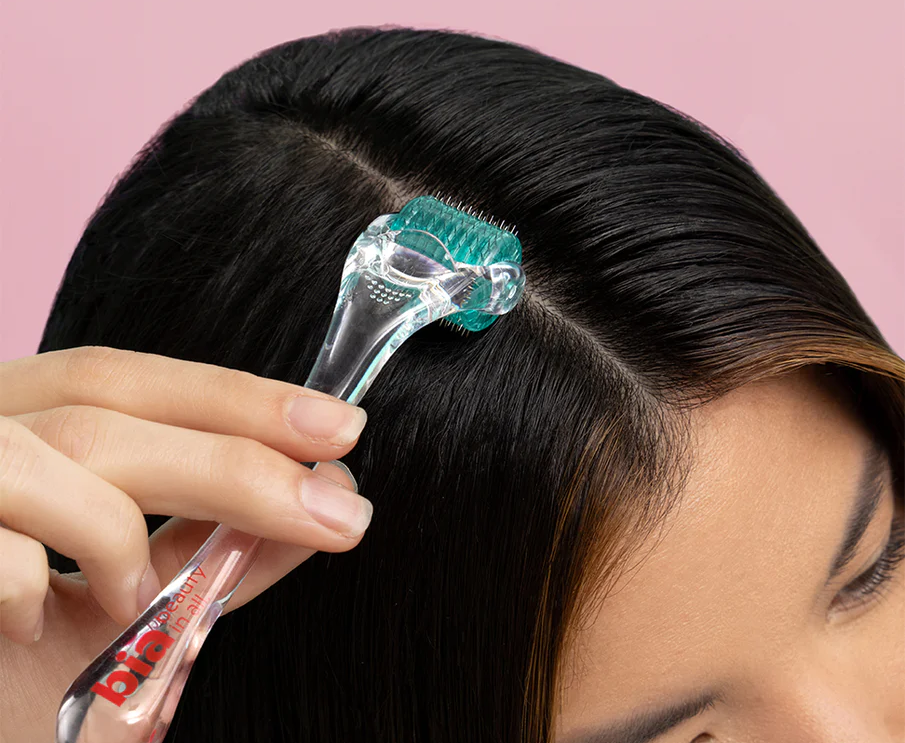A scalp roller is a handheld haircare tool designed to promote scalp health and stimulate hair growth. It typically consists of a handle and a roller with tiny, often metallic, pins or needles. Users gently roll the device over their scalp, creating micro-injuries that can help increase blood circulation, stimulate hair follicles, and encourage the absorption of topical hair growth products such as oils or serums.

What Are Scalp Rollers?
Scalp rollers, also known as derma rollers or microneedling devices, are handheld tools designed to stimulate the scalp by creating micro-injuries. These devices are equipped with tiny needles that gently penetrate the skin’s surface when rolled over the scalp. Scalp rollers come in various needle lengths, and their primary purpose is to enhance blood circulation, increase the absorption of hair growth products, and trigger the body’s natural healing response.
Benefits of Using Scalp Rollers
Scalp rollers are often used as part of a self-care routine to improve the overall condition of the scalp and hair. They are believed to help with issues like hair thinning, hair loss, and dandruff. Using scalp rollers can offer a wide range of benefits for your hair and scalp health.
Here are some of the key advantages:
Cleanliness: Always make sure your scalp roller is clean before and after each use. You can use alcohol or a mild disinfectant to sanitize the roller’s pins or needles. This prevents the transfer of bacteria to your scalp.
Hair Growth Promotion: Regular use of a scalp roller can stimulate hair follicles, promoting hair growth and reducing hair thinning. It’s an effective and non-invasive solution for those looking to combat hair loss.
Frequency: It’s recommended to use a scalp roller no more than a few times a week, as excessive use can irritate the scalp. Listen to your skin and adjust the frequency based on how your scalp responds.
Products: Some people like to apply hair growth serums or oils before or after using a scalp roller. This can help these products penetrate the scalp more effectively. However, consult with a dermatologist or hair specialist to ensure the products you’re using are suitable for your scalp and hair type.
Hair Length: Be mindful of your hair length when using a scalp roller. If you have longer hair, you may need to part it to ensure the roller makes direct contact with your scalp.
Clean Hands: Always wash your hands before using a scalp roller to maintain hygiene and prevent any dirt or oils from transferring to your scalp.
Relaxation and Stress Reduction: The gentle massage action of a scalp roller can provide a relaxing and stress-relieving experience. It’s a great way to unwind after a long day.
Consult a Professional: If you have specific scalp or hair concerns, it’s advisable to consult a dermatologist or trichologist (hair specialist) before incorporating a scalp roller into your routine. They can provide personalized advice and recommend the best approach for your unique needs.
How to Use Scalp Rollers?
Now that you understand the benefits of scalp rollers, let’s explore how to use them effectively for the best results.
Preparing Your Scalp
Before using a scalp roller, it’s essential to prepare your scalp properly. Here’s a step-by-step guide:
- Cleanse Your Scalp: Start with a gentle scalp cleanser to remove any dirt, oils, or product buildup.
- Dry Your Hair: Ensure your hair and scalp are completely dry before using the roller.
Using the Scalp Roller
Follow these instructions for using a scalp roller:
- Select the Right Needle Length: Choose a needle length that suits your needs. Shorter needles are suitable for general scalp stimulation, while longer needles may be used for specific concerns.
- Roll in Sections: Divide your scalp into sections and roll the device vertically, horizontally, and diagonally over each section. Apply gentle but consistent pressure.
- Avoid Overlapping: Ensure that you don’t roll over the same area multiple times during a single session.
- Apply Hair Growth Products: After rolling, apply your preferred hair growth serum or product to enhance absorption.
Post-Rolling Care
After using the scalp roller, it’s important to take proper care of your scalp:
- Clean the Roller: Disinfect your scalp roller with rubbing alcohol to prevent infections.
- Avoid Sun Exposure: Protect your scalp from direct sunlight immediately after rolling.
- Stay Hydrated: Drink plenty of water to support your body’s natural healing process.
In Conclusion
Incorporating a scalp roller into your haircare routine can be a game-changer for achieving healthier and more vibrant hair. The science behind it, coupled with the numerous benefits, makes it a worthwhile investment in your hair’s future. So, why wait? Start rolling your way to luscious locks today.
FAQs:
Q: How often should I use a scalp roller?
Ans: We recommend using a scalp roller once a week to start. You can adjust the frequency based on your hair’s response and your comfort level.
Q: Is scalp rolling painful?
Ans: When used correctly with gentle pressure, scalp rolling should not be painful. It may cause mild discomfort initially, but it should not be painful.
Q: Can I share my scalp roller with others?
Ans: It’s best not to share your scalp roller to prevent the risk of cross-contamination. Each person should have their own for hygiene reasons.
Q: Are there any side effects of using a scalp roller?
Ans: When used properly, side effects are minimal. However, some individuals may experience temporary redness or mild irritation, which usually subsides quickly.
Q: Can I use a scalp roller on wet hair?
Ans: It’s recommended to use a scalp roller on dry hair, as wet hair may be more prone to damage or tangling during the process.
Q: How long does it take to see results from using a scalp roller?
Ans: Results can vary from person to person, but many users report seeing improvements in hair texture and thickness within a few weeks to a few months of regular use.
